Product Development Department
Product Management Division
YANMAR SHIP BUILDING & ENGINEERING CO.,LTD.
YANMAR Technical Review
EX38A Fishing and Pleasure Boat
-Designed for Superior Comfort-
Abstract
Part of Yanmar's EX series of fishing boats and augmented with the additional features of a cruiser, the Wide EX series represent a new class of boat, the fishing cruiser, and are being accepted in the market. However, while Yanmar's range of medium-sized boats includes the EX33AII, which was originally released in 2009 with a minor design upgrade in 2013, and the EX30B released in 2014, sales of boats in 35- to 40-foot class that were previously only available in the EX series have been steadily falling. This created an urgent need for the development of a Wide EX series boat in this class.
The result was the release in 2015 of the EX38A, a new boat that represents a marked departure from previous Wide EX series models while still maintaining their comfort and suitability for fishing.
1. Introduction
The Yanmar EX38A was developed based on the product concept of building a "Deep Fishing Cruiser" to experience the full wonders of fishing in its various different forms, with a core design objective being the provision of new features to surpass the high bar set by the existing Wide EX series.
(1) Realize cruising performance equal to that of a 40-foot boat
⇒ Development of new hull form
(2) Lower vibration and noise
⇒ Redesign of front power take off (PTO) of the main engine and sound shielding structure of the engine room
(3) Ensure cabin space equal to that of a cruiser and improve comfort
⇒ Improvements to boat fittings
2. Product Profile
The following gives an overview of the EX38A.
2.1. Styling
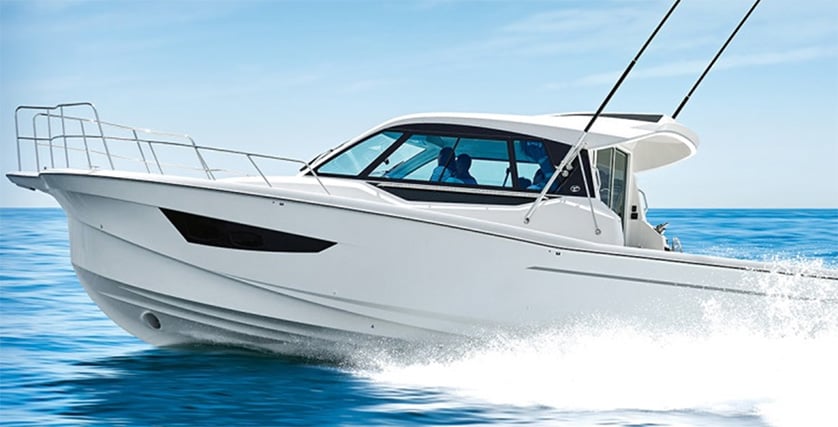
2.2. Main Specifications
Table 1 Main Specifications

Table 2 Installed Engine
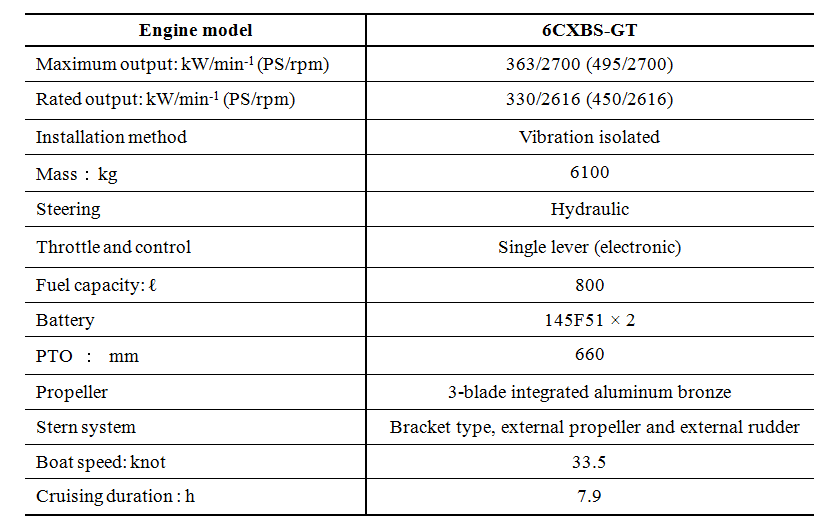
3. Incorporation of Technology and Resulting Benefits
3.1. Development of New Hull Form
The Wide EX series was designed to provide even greater comfort than before with regard to those features expected for a cruiser, particularly the spatial capacity of the bow berths. As adequate volume in the hull is essential to these features, this imposed design constraints on the bow shape, which in turn influences cruising performance. While comfort aboard on the Wide EX series was considered adequate, the objective for the EX38A was to provide a higher class of comfort aboard that improved on the previous model. Furthermore, in designing the EX38A, Challenges never attempted before, the conflicting objectives associated with improving on the features required for cabin space by achieving the cruising performance equal to that of a 40-feet boat despite only 38 feet, were selected to be overcome.
Given the same breadth and hull form, cruising performance typically improves with longer waterline length. With the length of the boat having been decided, one way to make the waterline length longer is to have a more upright stem, but this detracts from cruising performance and increases wave-making resistance simply by raising the hull bottom slope relative to the waterline. Accordingly, a shape with an inflection point where the stem meets the chine was designed. This enables only the waterline length to be made longer without raising the hull bottom slope, and without affecting the shape of the sides of the hull. It also means that the cabin space requirements can be achieved without the hull sides degrading cruising performance. (See Fig. 2)
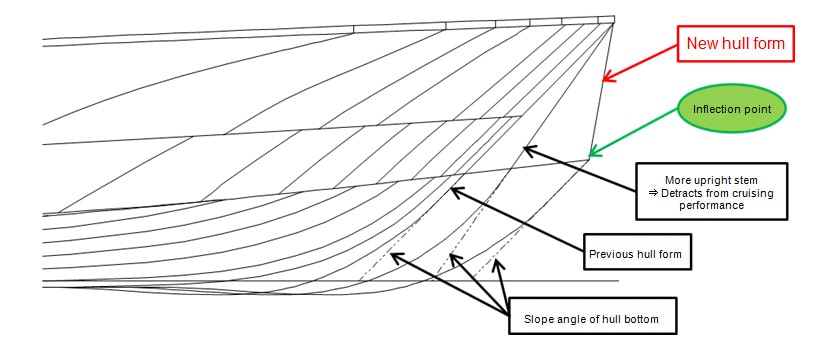
One effect of the new full form was the lower vertical acceleration at the helm due to the longer waterline length by using hull form with inflection point on the stem. The graph in Fig. 3 shows the distance from the bow to the helm and the change in vertical acceleration at this point relative to the vertical acceleration at the bow (4G). The ratio of the vertical acceleration relative to that at the bow was improved by 45 percentage points from 55% for the previous model to 10 % for the new model. This provided a very stable cruising, with no unpleasant vertical movement and with a sense of stability that is on par with a 40-feet boat.
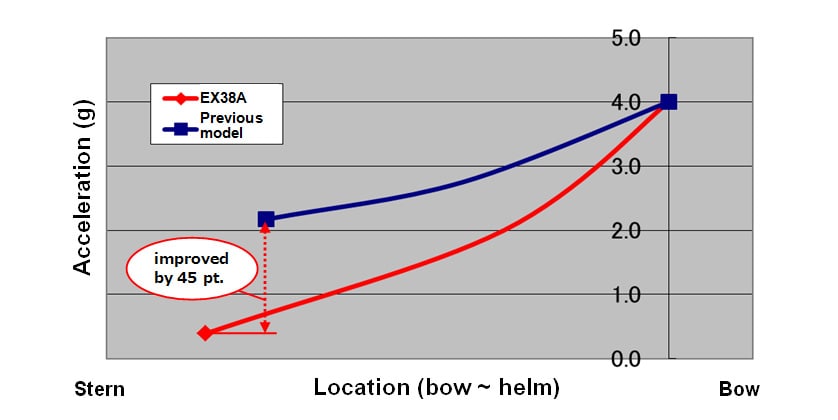
The other effect of the new hull form was that the change of the buoyant force at the inflection point on the stem provided changes of the sensitive acceleration when moving through waves. Because the bow in the previous hull form became submersed as far as the bow flare, it experienced high values of vertical acceleration due to the reaction. This repetition is one of the factors that cause stress to passengers, therefore a hull form was adopted that would change (increase) the buoyant force in the vicinity of the inflection point on the stem (see Fig. 4). By using this change in buoyant force, the sensitive acceleration for passengers was changed gradually and dispersed to succeed in reducing stress on passengers.
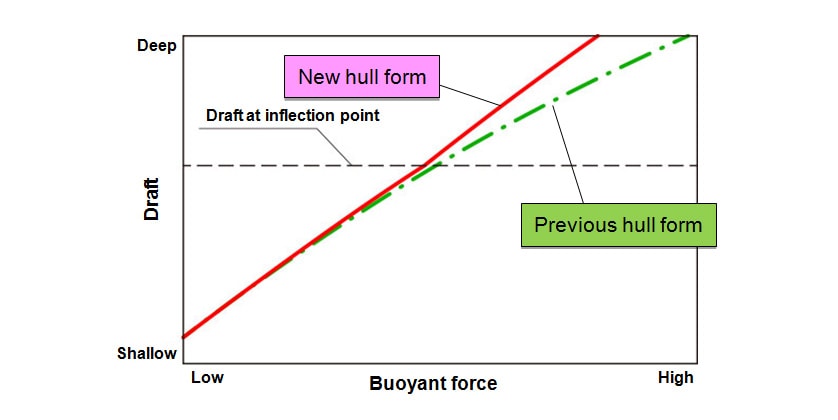
Two incidental effects of the new hull form were to enlarge the capacity of the anchor locker in the bow and to make the bow thrusters more effective by shifting them further to the bow.
However, because the bow appearance represents the "face of the boat" and is an important factor in its appeal to users, to get the shape adopted, it was necessary to gain the approval of the marketing team during the product planning stage. Numerous modifications were made to gain the approval for the design before the final model was confirmed, and the new hull form was agreed to after presenting the performance benefits described above and obtaining a general understanding. (See Fig. 5)
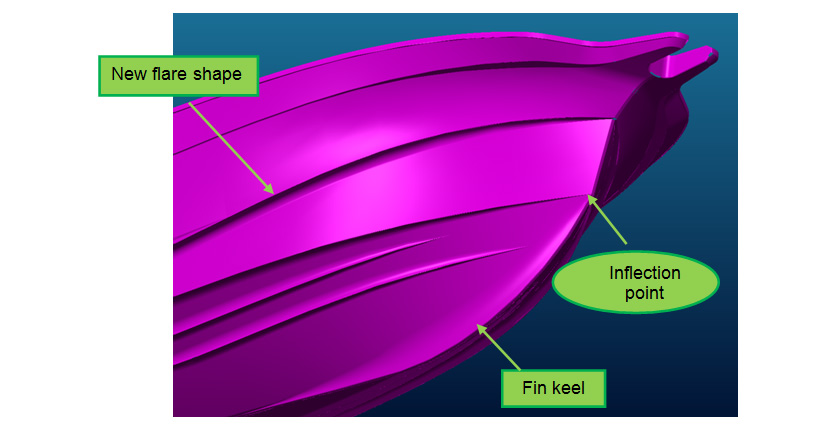
3.2. Lower Vibration and Noise
Recent times have seen boats with electronically controlled engines become common, with very strong market demand for quietness. While the 6CXB-GT engine in the EX38A is mechanically controlled, it still needed to provide a high level of performance similar to that of electronically controlled engines. Accordingly, the front PTO and shielding structure was redesigned to meet this challenge.
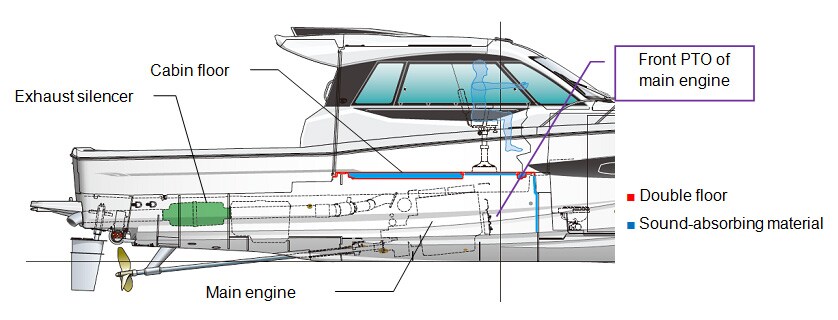
Recent years have seen strong market demand for greater drive power from the front PTO due to the growing diversity of auxiliary equipment such as air conditioners and generators. In the previous front PTO system, the multiple equipment units are mounted on platforms attached to the hull and driven individually using belts. Having to perform installation in a confined space limited how well the belts can be aligned, making them a source of vibration or noise. Accordingly, an integrated front PTO system as a single unit to improve belt alignment accuracy was adopted. All of the equipment and the front PTO were mounted on the same platform so they could be located as close together as possible to improve belt alignment accuracy, and flexible couplings were used for connecting the front PTO and the engine to isolate transmission of vibrations from the engine and to minimize the influence to the hull. By using this system vibration and noise were reduced and the amount of work required for installation was also reduced significantly that make a major contribution to quality. (See Fig. 7)
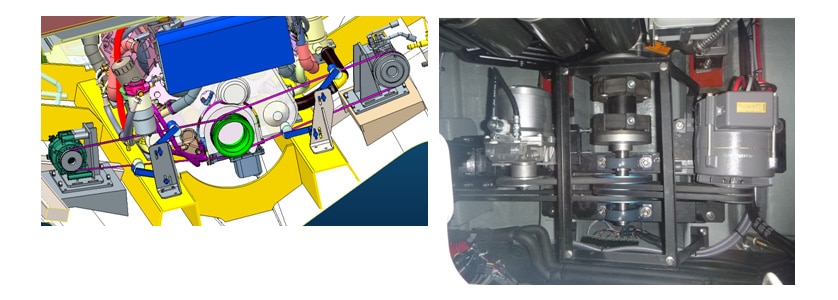
For the sound shielding structure, the double floor design that is unique to the EX series was modified by changing the layout of hatches in the cabin floor together with a careful redesign of the engine room sound shielding structure based on experience from previous models. This succeeded in reducing the level of noise by 5 to 7 dB(A) compared to the previous model (when mounted with the same type of engine). In particular, only 61 dB(A) of sound pressure level at mooring condition was achieved and it was much quieter than before. (See Fig. 8)
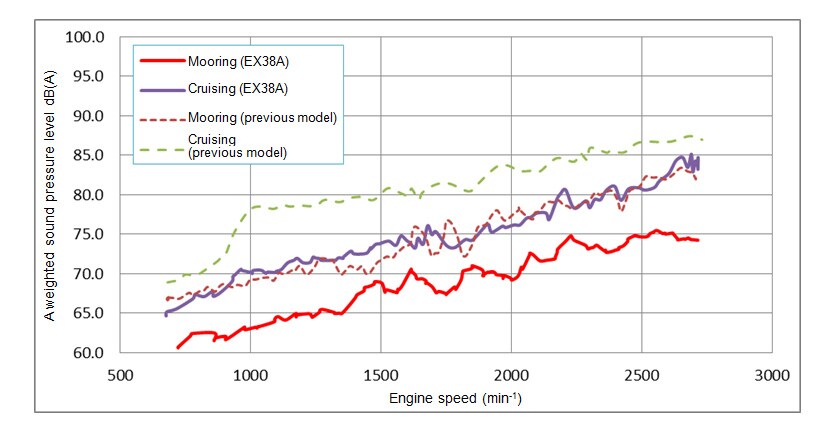
The level of vibration was also improved at the low and middle engine speed range, which is most sensitive for the feeling, due to the effect of the integrated front PTO system. (See Fig. 9)
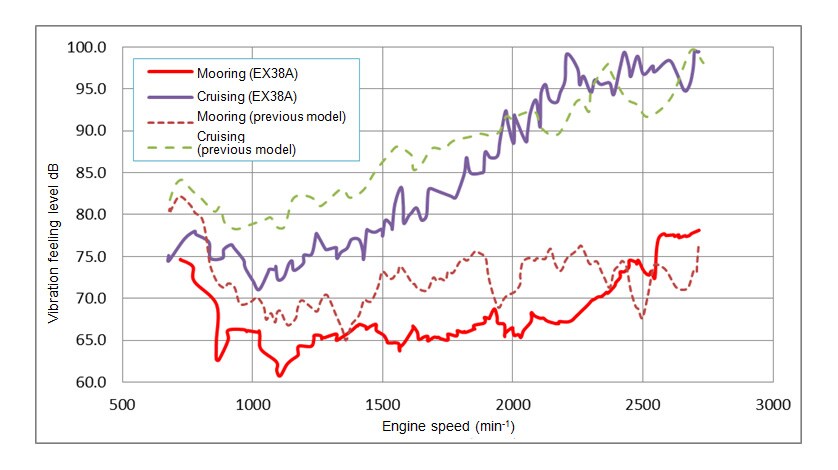
3.3. Improvements to Fittings
To improve cabin space and comfort on a par with a cruiser, upgrades of the engine control system was implemented. The EX38A has a mechanically controlled engine and it was necessary to redesign the system from scratch, the challenges being to provide more legible gauges and a throttle and controls that are easier to operate. The system was developed to incorporate Livorsi gauges and an engine on/off panel, making the gauges smaller and providing benefits that included space for installing a navigation monitor or similar. Providing electronic throttle control as a standard feature also enhanced the product appeal by making a major contribution to the visual appearance, ease-of-viewing, and ease-of-operation of the helm.
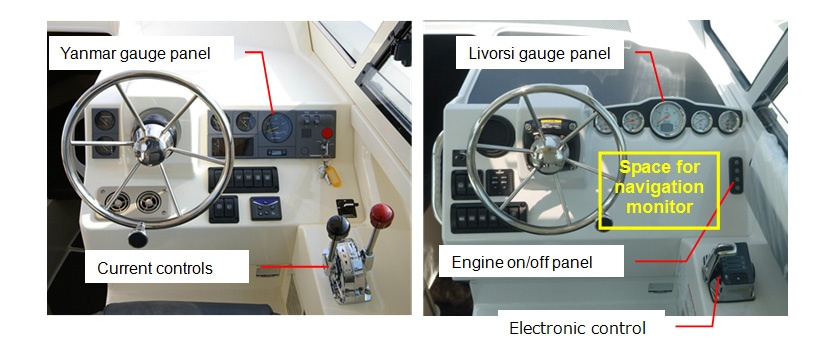
In response to market feedback, the atmosphere of the cabin was made more like that of a cruiser. Indirect lighting was installed in various locations and functional aspects such as seat covers and cushioning were also carefully redesigned to create a high quality space surpassing that of any previous fishing boat. These enhancements are well received by women in particular and are major factors to increase purchasing wills in the family market, despite its being a fishing boat.
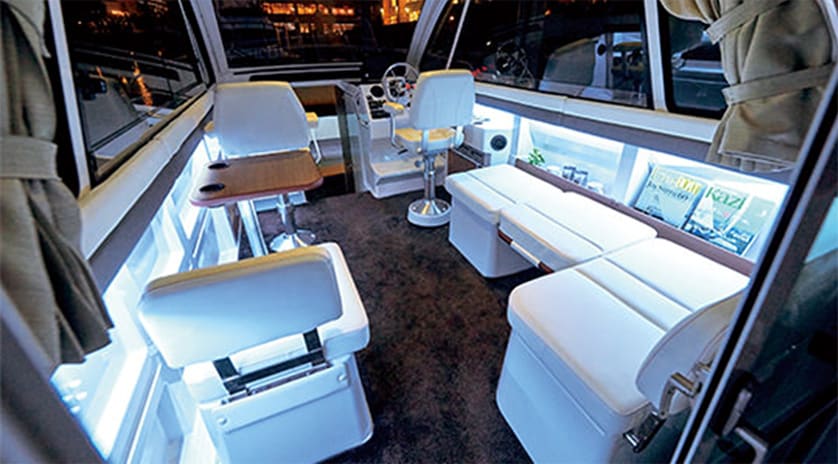
4. Reception and Performance
The challenge for the cabin design was to create a design that is felt different from that of previous models while still sticking to the same basic design concept for the series. A demonstration model of the boat was exhibited at the 2015 Yokohama Boat Show where the interior attracted a very high level of interest along with the innovativeness of the hull form. The boat's styling and cruising performance were also well-received at a series of trial boating events that were subsequently held in various locations.
The EX38A then went on to win the 2015 Japan Boat of the Year (large Japanese-made boat category) in the following year's Yokohama Boat Show, a first for a Yanmar boat, demonstrating the all-round regard in which it was held and boosting confidence in its future.
Having gone on sale on August 1, 2015, scheduled production for FY2016 is 41 boats and a steady stream of orders is being received.
5. Conclusions
Although the development had to overcome difficult challenges on a tight schedule amid pressure to develop a scaled-up model of the mid-range class in the Wide EX series, which continues to sell well, we believe that our successful collaboration with other departments to overcome these challenges is a positive sign for future development.
By listening to market feedback and looking at products through the eyes of customers, Yanmar intends in the future to strive to incorporate the information obtained into new products in better ways.
-IMPORTANT-
The original technical report is written in Japanese.
This document was translated by Research & Development Management Division.
Author
